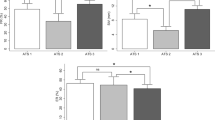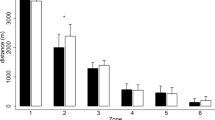Abstract
Tennis is a sport in which the surface plays an important role in performance and injury risk. Professional players face an extensive competition calendar in which they must adapt to different types of surfaces. However, unlike other sports, tennis lacks standards that regulate surface properties affecting athlete–surface interaction. The objective of this study was to mechanically evaluate shock absorption, vertical deformation, energy restitution and slip resistance in different types of tennis surfaces, compare them with each other and look for correlations between variables. Thirty-six tennis courts (12 hard court, 16 clay, 8 artificial grass) were evaluated. All variables differed significantly between surfaces (p < 0.001). Shock absorption (1.1 ± 0.5 to 13.9 ± 3.4%) and vertical deformation (0.02 ± 0.04 to 1.07 ± 0.19 mm) were lower on hard court compared to clay and artificial grass; energy restitution (72.5 ± 4.7 to 89.9 ± 1.5%) showed the opposite; and slip resistance (in Pendulum Test Value) was lower on clay (53.6 ± 2.5) compared to grass (61.4 ± 1.3) and hard court (66.6 ± 1.1). No significant correlations between variables were identified in hard court. However, both clay and artificial grass showed a significant positive correlation (p < 0.001) between shock absorption and vertical deformation (0.872 and 0.947, respectively), and a significant negative correlation (p < 0.001) between shock absorption and energy restitution (− 0.807 and − 0.981, respectively). Also, significant negative correlations were found between vertical deformation and energy restitution both in clay (− 0.802; p < 0.001) and artificial grass surfaces (− 0.890; p < 0.01). As for the shock absorption, only a significant negative correlation with vertical deformation in artificial grass (− 0.715; p < 0.05) was identified. This study contributes initial evidence for further research to inform future International Tennis Federation regulations aimed to assess and control the mechanical properties of tennis surfaces affecting athlete–surface interaction.
Similar content being viewed by others
Data availability
We have included the data in complementary materials.
References
Kovacs MS (2006) Applied physiology of tennis performance. Br J Sports Med 40(5):381–385. https://doi.org/10.1136/bjsm.2005.023309. (discussion 6)
Fu MC, Ellenbecker TS, Renstrom PA, Windler GS, Dines DM (2018) Epidemiology of injuries in tennis players. Curr Rev Musculoskelet Med 11(1):1–5. https://doi.org/10.1007/s12178-018-9452-9
Dines JS, Bedi A, Williams PN, Dodson CC, Ellenbecker TS, Altchek DW et al (2015) Tennis injuries: epidemiology, pathophysiology, and treatment. J Am Acad Orthop Surg 23(3):181–189. https://doi.org/10.5435/JAAOS-D-13-00148
Kaiser P, Stock K, Benedikt S, Ellenbecker T, Kastenberger T, Schmidle G et al (2021) Acute tennis injuries in the recreational tennis player. Orthop J Sports Med 9(1):2325967120973672. https://doi.org/10.1177/2325967120973672
Damm L, Low D, Richardson A, Clarke J, Carre M, Dixon S (2013) The effects of surface traction characteristics on frictional demand and kinematics in tennis. Sports Biomech 12(4):389–402. https://doi.org/10.1080/14763141.2013.784799
Ferens CHR, Alencar CAB, Costa GLL, Pacheco JCC, Andrade LM, Filgueiras R et al (2022) Proposition of irrigation system for wetting the clay surface of tennis courts. PLoS ONE 17(10):e0275571. https://doi.org/10.1371/journal.pone.0275571
Ura D, Carré MJ, Charlton H, Capel-Davies J, Miller S, Almenara MS et al (2014) Influence of clay properties on shoe-kinematics and friction during tennis movements. Procedia Eng 72:889–894. https://doi.org/10.1016/j.proeng.2014.06.152
Andersson H, Ekblom B, Krustrup P (2008) Elite football on artificial turf versus natural grass: movement patterns, technical standards, and player impressions. J Sports Sci 26(2):113–122. https://doi.org/10.1080/02640410701422076
Brito J, Krustrup P, Rebelo A (2012) The influence of the playing surface on the exercise intensity of small-sided recreational soccer games. Hum Mov Sci 31(4):946–956. https://doi.org/10.1016/j.humov.2011.08.011
Hughes MG, Birdsey L, Meyers R, Newcombe D, Oliver JL, Smith PM et al (2013) Effects of playing surface on physiological responses and performance variables in a controlled football simulation. J Sports Sci 31(8):878–886. https://doi.org/10.1080/02640414.2012.757340
Sanchez-Sanchez J, Garcia-Unanue J, Jimenez-Reyes P, Gallardo A, Burillo P, Felipe JL et al (2014) Influence of the mechanical properties of third-generation artificial turf systems on soccer players’ physiological and physical performance and their perceptions. PLoS ONE 9(10):e111368. https://doi.org/10.1371/journal.pone.0111368
Dixon SJ, Stiles V (2003) Impact absorption of tennis shoe–surface combinations. Sports Eng 6(1):1–9. https://doi.org/10.1007/BF02844155
Colino E, Sánchez-Sánchez J, García-Unanue J, Ubago-Guisado E, Haxaire P, Le Blan A et al (2017) Validity and reliability of two standard test devices in assessing mechanical properties of different sport surfaces. Polym Test 62:61–67. https://doi.org/10.1016/j.polymertesting.2017.06.011
McGhie D, Ettema G (2013) Biomechanical analysis of surface-athlete impacts on third-generation artificial turf. Am J Sports Med 41(1):177–185. https://doi.org/10.1177/0363546512464697
Nigg BM (1990) The validity and relevance of tests used for the assessment of sports surfaces. Med Sci Sports Exerc 22(1):131–139. https://doi.org/10.1249/00005768-199002000-00021
ITF. ITF Approved Tennis Balls, Classified Surfaces & Recognised Courts 2023—a guide to products and test methods. London (UK)2023. https://www.itftennis.com/media/4420/2023-technical-booklet.pdf
Nigg BM, Segesser B (1988) The influence of playing surfaces on the load on the locomotor system and on football and tennis injuries. Sports Med 5(6):375–385. https://doi.org/10.2165/00007256-198805060-00003
Pavailler S, Horvais N (2014) Sliding allows faster repositioning during tennis specific movements on hard court. Procedia Eng 72:859–864. https://doi.org/10.1016/j.proeng.2014.06.157
Starbuck C, Damm L, Clarke J, Carré M, Capel-Davis J, Miller S et al (2016) The influence of tennis court surfaces on player perceptions and biomechanical response. J Sports Sci 34(17):1627–1636. https://doi.org/10.1080/02640414.2015.1127988
Starbuck C, Stiles V, Urà D, Carré M, Dixon S (2017) Biomechanical responses to changes in friction on a clay court surface. J Sci Med Sport 20(5):459–463. https://doi.org/10.1016/j.jsams.2016.08.019
Clarke J, Dixon SJ, Damm L, Carré M (2013) The effect of normal load force and roughness on the dynamic traction developed at the shoe–surface interface in tennis. Sports Eng 16(3):165–171. https://doi.org/10.1007/s12283-013-0121-3
Goff JE, Boswell L, Ura D, Kozy M, Carré M (2017) Critical shoe contact area ratio for sliding on a tennis hard court. Proc Inst Mech Eng, Part P: J Sports Eng Technol 232(2):112–121. https://doi.org/10.1177/1754337117715341
Miller S, Capel-Davies J (2006) An initial ITF study on performance standards for tennis court surfaces. In: Proceedings of the Sport Surf 2nd Workshop. Cranfield University, UK
FIFA (2015) FIFA Quality Programme for Artificial Turf - Handbook of Test Methods. October 2015 ed. https://digitalhub.fifa.com/m/f13b1cd18027f40/original/FIFA-quality-programme-for-football-turf-Test-Manual-I-Test-Methods-2015v-3-4.pdf
Gimenez JV, Jimenez-Linares L, Garcia-Unanue J, Sanchez-Sanchez J, Gallardo L, Felipe JL (2020) Analyse success model of split time and cut-off point values of physical demands to keep category in semi-professional football players. Appl Sci 10(5):5299. https://doi.org/10.3390/app10155299
CEN. EN 15330-2 (2017) Surfaces for sport areas. Synthetic turf and needle-punched surfaces primarily designed for outdoor use. Part 2: specification for needle-punched surfaces for tennis and multi-sport surfaces
Damm L, Starbuck C, Stocker N, Clarke J, Carré M, Dixon S (2014) Shoe–surface friction in tennis: influence on plantar pressure and implications for injury. Footw Sci 6(3):155–164. https://doi.org/10.1080/19424280.2014.891659
Abrams GD, Renstrom PA, Safran MR (2012) Epidemiology of musculoskeletal injury in the tennis player. Br J Sports Med 46(7):492–498. https://doi.org/10.1136/bjsports-2012-091164
Minghelli B, Cadete J (2019) Epidemiology of musculoskeletal injuries in tennis players: risk factors. J Sports Med Phys Fitness 59(12):2045–2052. https://doi.org/10.23736/S0022-4707.19.09842-6
Pluim BM, Clarsen B, Verhagen E (2018) Injury rates in recreational tennis players do not differ between different playing surfaces. Br J Sports Med 52(9):611–615. https://doi.org/10.1136/bjsports-2016-097050
Acknowledgements
The lines of gratitude are dedicated to the Tennis Clubs of Madrid for providing the courts for our work.
Funding
No funding was received for conducting this study.
Author information
Authors and Affiliations
Corresponding author
Ethics declarations
Conflict of interest
The authors have no competing interests to declare that are relevant to the content of this article.
Additional information
Publisher's Note
Springer Nature remains neutral with regard to jurisdictional claims in published maps and institutional affiliations.
Supplementary Information
Below is the link to the electronic supplementary material.
Rights and permissions
Springer Nature or its licensor (e.g. a society or other partner) holds exclusive rights to this article under a publishing agreement with the author(s) or other rightsholder(s); author self-archiving of the accepted manuscript version of this article is solely governed by the terms of such publishing agreement and applicable law.
About this article
Cite this article
Colino, E., García-Unanue, J., Felipe, J.L. et al. Mechanical properties influencing athlete–surface interaction on tennis court surfaces. Sports Eng 27, 18 (2024). https://doi.org/10.1007/s12283-024-00461-9
Accepted:
Published:
DOI: https://doi.org/10.1007/s12283-024-00461-9




